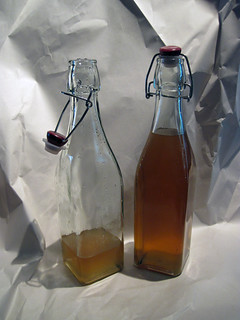

This project predates my stated inspiration of the Adventures in Booze series, but only by a few days and was informed by my reading. We visited Onegin in NYC in June (warning: Flash heavy restaurant website. *sigh*) at recommendation of our hotel. The food was fantastic. We also decided to start out dinner with some of the house infused vodkas. I had the pear ginger vodka which was just fantastic.
I figured that it was probably something I could do myself at home. The internet agreed with me so I decided to give it a go. You can see my starting point in the first picture above. Basically I took 2 Asian pears, cored and sliced, and a couple of inches of ginger, peeled and sliced, and layered them in a jar. I left the skins on the pears since I figured, like apples, that’s where the most flavor is. Then I topped it all with a mid-range vodka and stuck it in the cupboard. A lot of the recipes I found online also called for adding a crapton of sugar. I left it out because I’m trying to cut down on extra sugar (she says, embarking on an alcohol-based drinking project) and I thought it might make it more versatile without the extra sugar. Also, Jason and I have different sweet levels we like and I wanted something both of us would enjoy.
I let it steep for about a week, maybe 10 days. I stirred it every couple of days to move the browning fruit around and to check the taste. At first the ginger was first and foremost. A bit of a ginger smack to the face. But then it settled down and the pear made itself known.
In the finished product, there’s a nice level of both flavors. Since I didn’t add any sugar, the sweetness is all from the fruit and is nicely light. I find it sweet enough to enjoy by itself over ice and Jason doesn’t find it overly sweet at all. “Pleasantly fruity” he says. I find both flavors to be subtle and I don’t think I’d want to mix it with anything because the tastes that you spend so long coaxing out would get lost.
I think the next time I make this I’m going to try it with different pears. Especially if I can find some really ripe ones, perhaps from a local orchard. I’m not actually sure if we have any around here. Lots of apples and peaches, but no idea on pears. Anyway, I think something riper and more flavorful would be better than the Asian pears I picked up. But it may also have to wait until I have jar space again…